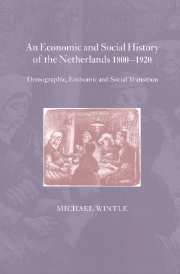 An Economic and Social History of the Netherlands, 1800–1920
An Economic and Social History of the Netherlands, 1800–1920 Book contents
- Frontmatter
- Contents
- List of plates
- List of figures
- List of tables
- Acknowledgements
- General introduction
- Part I Demography, and the health of the nation
- 1 Demographic indicators
- 2 The condition of the people: public health, diet and nutrition
- Part II Economic Transition
- Part III Social transition: state, society, individual and nation
- General conclusion
- Bibliography
- Index
2 - The condition of the people: public health, diet and nutrition
Published online by Cambridge University Press: 13 August 2009
- Frontmatter
- Contents
- List of plates
- List of figures
- List of tables
- Acknowledgements
- General introduction
- Part I Demography, and the health of the nation
- 1 Demographic indicators
- 2 The condition of the people: public health, diet and nutrition
- Part II Economic Transition
- Part III Social transition: state, society, individual and nation
- General conclusion
- Bibliography
- Index
Summary
The public health environment
In chapter 1 the condition of the people of the Netherlands came under examination in terms of that population's demographic behaviour; now the focus will narrow to a rather closer range: the questions asked will concern the immediate environment of the Dutch people in the long nineteenth century, and the ways in which their daily lives were affected by these health-related matters. What was life like a hundred years ago, and what were its preoccupations? Were people terrified of death and disease, and which diseases were they most likely to contract? What was their attitude to food? What did they eat? What did they drink? What was the cultural backdrop to food? When did these things change, and why? As well as seeking established patterns, we shall also be looking for changes, and, in that some of the changes were steps in a direction leading to our own society of today, we shall be concerned with the ‘modernization’ of Dutch society. We shall also be seeking to amplify some of the demographic analyses offered: how did the population come to live longer, causing the numbers of people to rise, more labour to be available, and more demand to be generated?
The health-related environment at the beginning of the nineteenth century is difficult to gauge exactly, because of the lack of benchmarks, but there can be little doubt that conditions were atrocious by the standards of today.
- Type
- Chapter
- Information
- An Economic and Social History of the Netherlands, 1800–1920Demographic, Economic and Social Transition, pp. 40 - 68Publisher: Cambridge University PressPrint publication year: 2000
